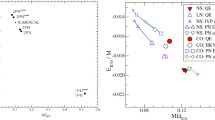Abstract
This paper considers the energy required for collections of finite-density bodies to undergo escape under internal gravitational interactions alone. As the level of the system energy is increased, there are different combinations of components that can escape, until the total energy becomes positive, when the entire system can undergo mutual disruption. The results are also defined for bodies modeled as a continuum. These results provide rigorous constraints for the disruption of rubble-pile asteroids when only considering gravitational interaction effects, with the energy provided by rotation of an initial collection of the system. These issues are considered for discrete particles in the N-body problem and for size distributions of discrete particles in the continuum limit.





Similar content being viewed by others
References
Andrews, G.E.: The Theory of Partitions. Number 2. Cambridge University Press, Cambridge (1998)
Berend, D., Tassa, T.: Improved bounds on bell numbers and on moments of sums of random variables. Probab. Math. Stat. 30(2), 185–205 (2010)
Hirabayashi, M., Scheeres, D.J.: Stress and failure analysis of rapidly rotating asteroid (29075) 1950 DA. Astrophys. J. Lett. 798(1), L8 (2015)
Holsapple, K.A.: Equilibrium configurations of solid cohesionless bodies. Icarus 154(2), 432–448 (2001)
Michikami, T., Nakamura, A.M., Hirata, N., Gaskell, R.W., Nakamura, R., Honda, T., et al.: Size-frequency statistics of boulders on global surface of asteroid 25143 Itokawa. Earth Planets Space 60(1), 13–20 (2008)
Moeckel, R.: Minimal energy configurations of gravitationally interacting rigid bodies. Celest. Mech. Dyn. Astron. 128(1), 3–18 (2017)
Moeckel, R.: Counting relative equilibrium configurations of the full two-body problem. Celest. Mech. Dyn. Astron. 130(2), 17 (2018)
Pravec, P., Fatka, P., Vokrouhlický, D., Scheeres, D.J., Kušnirák, P., Hornoch, K., et al.: Asteroid clusters similar to asteroid pairs. Icarus 304, 110–126 (2018). (Asteroids and Space Debris)
Pravec, P., Vokrouhlický, D., Polishook, D., Scheeres, D.J., Harris, A.W., Galád, A., et al.: Formation of asteroid pairs by rotational fission. Nature 466(7310), 1085–1088 (2010)
Sánchez, P., Scheeres, D.J.: The strength of regolith and rubble pile asteroids. Meteorit. Planet. Sci. 49(5), 788–811 (2014)
Scheeres, D.J.: Stability in the full two-body problem. Celest. Mech. Dyn. Astron. 83(1), 155–169 (2002)
Scheeres, D.J.: Rotational fission of contact binary asteroids. Icarus 189(2), 370–385 (2007)
Scheeres, D.J.: Minimum energy configurations in the \(N\)-body problem and the celestial mechanics of granular systems. Celest. Mech. Dyn. Astron. 113(3), 291–320 (2012)
Scheeres, D.J.: Relative equilibria in the full \(N\)-body problem with applications to the equal mass problem. In: Recent Advances in Celestial and Space Mechanics, pp. 31–81. Springer (2016a)
Scheeres, D.J.: Relative equilibria in the spherical, finite density three-body problem. J. Nonlinear Sci. 26(5), 1445–1482 (2016b)
Tsuchiyama, A., Uesugi, M., Matsushima, T., Michikami, T., Kadono, T., Nakamura, T., et al.: Three-dimensional structure of Hayabusa samples: origin and evolution of Itokawa Regolith. Science 333(6046), 1125–1128 (2011)
Vokrouhlicky, D., Bottke, W.F., Chesley, S.R., Scheeres, D.J., Statler, T.S.: The Yarkovsky and YORP Effects. Asteroids IV. Univ. Arizona Press, Tucson (2015)
Acknowledgements
The author appreciates the comments of the two reviewers, which have helped to greatly improve this paper.
Funding
Funding was provided by National Aeronautics and Space Administration (Grant No. 80NSSC18K0491).
Author information
Authors and Affiliations
Corresponding author
Ethics declarations
Conflict of interest
The author declares that no conflict of interest exists with the research reported herein.
Additional information
Publisher's Note
Springer Nature remains neutral with regard to jurisdictional claims in published maps and institutional affiliations.
This article is part of the topical collection on 50 years of Celestial Mechanics and Dynamical Astronomy.
Guest Editors: Editorial Committee.
Appendix: Size distribution functions
Appendix: Size distribution functions
Consider a cumulative size distribution of the form \(\mathcal{N}_{\alpha }(r) = \frac{A_\alpha }{r^\alpha }\) for \(2 \le \alpha \le 3\). Associated with this distribution is a maximum and minimum grain radius, \(r_1\) and \(r_0\), respectively. The function \(\mathcal{N}_{\alpha }(r)\) is the cumulative number of particles with radius between r and the maximum size \(r_1\). The term \(A_\alpha \) is initially chosen to agree with the observed number of largest boulders, \(\mathcal{N}_1\), such that \(\mathcal{N}_{\alpha }(r_1)=\mathcal{N}_1\). With this interpretation, the nominal form for the function is:
The cumulative distribution is the integral of a cumulative density function \(n_\alpha (r)\), defined as:
This definition establishes that \(n_\alpha (r) = - \frac{d\mathcal{N}_{\alpha }}{\hbox {d}r}\), leading to the cumulative density function
A density distribution function that integrates to unity can also be defined, denoted as \(\bar{n}_\alpha (r)\):
Carrying out this computation yields
There are several quantities of interest that can be defined and calculated with a power law size distribution. A few of them are reviewed here, in addition to stating some key results used in the paper.
Mean grain radius The mean grain radius is defined as
Thus, if \(r_0 \ll r_1\), the mean radius is \(\bar{r} \sim \frac{\alpha }{\alpha -1} r_0\).
Surface area of grains The total surface area of a collection of grains is computed as
If \(2 < \alpha \le 3\), this can be integrated to find
and if \(\alpha = 2\), the total surface area equals
For either case, if \(r_0 \ll r_1\), the total surface area becomes arbitrarily large.
Volume of grains The total volume of grains can be found by
If \(2 \le \alpha < 3\), the total volume equals
If \(\alpha = 3\), the total volume equals
For \(\alpha < 3\), one can take the limit \(r_0\rightarrow \infty \) without any singularity. For \(\alpha =3\), however, this leads to an infinite mass.
Total self-potential Finally, the total self-potential of a size distribution, assuming spherical grains, is computed as
The integral is defined for the whole interval of \(2\le \alpha \le 3\), yielding
Across the entire interval, the limit \(r_0\rightarrow 0\) can be taken.
Rights and permissions
About this article
Cite this article
Scheeres, D.J. Disassociation energies for the finite-density N-body problem. Celest Mech Dyn Astr 132, 4 (2020). https://doi.org/10.1007/s10569-019-9945-x
Received:
Revised:
Accepted:
Published:
DOI: https://doi.org/10.1007/s10569-019-9945-x




